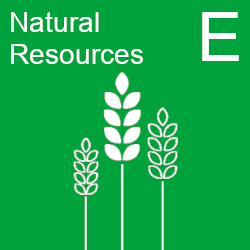Short Description
Agriculture provides around 75% of the indigenous food we eat (food which can be produced in the climatic conditions of the UK) and accounts for around 70% of land use. As well as being vital for food production, agriculture helps to shape the landscape, providing important recreational, spiritual and other cultural benefits. This indicator shows annual changes in land used for agriculture in 3 categories: grassland (including sole rough grazing); crops (including horticulture and perennial crops); and uncropped arable (land left fallow or under environmental management). Agricultural production and the associated land use and management are key drivers of the environmental impacts from the sector. A key policy challenge is to de-couple production from environmental impact. The indicator may be considered a measure of pressure on the environment, a measure of condition of the land asset, or a measure of service/benefit we derive from the land. The indicator is included in the framework to provide contextual information.
Readiness and links to data
Data on the structure of the agricultural industry in England are published annually as accredited official statistics.
Indicator components
Figure E1: Area of productive agricultural land in England, 1983 to 2024
Table E1: Area of productive agricultural land in England, 1983 to 2024
| Year | Crops | Grassland | Uncropped arable |
|---|---|---|---|
| 1983 | 4.24 | 4.87 | 0.09 |
| 1984 | 4.34 | 4.82 | 0.03 |
| 1985 | 4.40 | 4.74 | 0.03 |
| 1986 | 4.42 | 4.71 | 0.04 |
| 1987 | 4.44 | 4.69 | 0.03 |
| 1988 | 4.44 | 4.66 | 0.05 |
| 1989 | 4.36 | 4.66 | 0.04 |
| 1990 | 4.27 | 4.69 | 0.11 |
| 1991 | 4.22 | 4.69 | 0.13 |
| 1992 | 4.24 | 4.62 | 0.17 |
| 1993 | 3.84 | 4.58 | 0.62 |
| 1994 | 3.80 | 4.54 | 0.66 |
| 1995 | 3.87 | 4.48 | 0.58 |
| 1996 | 4.02 | 4.43 | 0.46 |
| 1997 | 4.24 | 4.35 | 0.28 |
| 1998 | 4.23 | 4.31 | 0.29 |
| 1999 | 4.00 | 4.27 | 0.52 |
| 2000 | 3.98 | 4.13 | 0.51 |
| 2001 | 3.79 | 4.32 | 0.73 |
| 2002 | 3.90 | 4.32 | 0.54 |
| 2003 | 3.81 | 4.32 | 0.61 |
| 2004 | 3.91 | 4.33 | 0.50 |
| 2005 | 3.87 | 4.40 | 0.53 |
| 2006 | 3.79 | 4.59 | 0.49 |
| 2007 | 3.80 | 4.57 | 0.42 |
| 2008 | 4.03 | 4.64 | 0.16 |
| 2009 | 3.90 | 4.40 | 0.22 |
| 2010 | 3.92 | 4.37 | 0.15 |
| 2011 | 3.96 | 4.36 | 0.14 |
| 2012 | 4.04 | 4.35 | 0.14 |
| 2013 | 3.96 | 4.41 | 0.24 |
| 2014 | 4.01 | 4.40 | 0.15 |
| 2015 | 3.98 | 4.34 | 0.18 |
| 2016 | 3.99 | 4.39 | 0.22 |
| 2017 | 4.05 | 4.40 | 0.20 |
| 2018 | 3.99 | 4.41 | 0.23 |
| 2019 | 4.03 | 4.43 | 0.19 |
| 2020 | 3.80 | 4.39 | 0.33 |
| 2021 | 3.88 | 4.31 | 0.23 |
| 2022 | 3.86 | 4.43 | 0.24 |
| 2023 | 3.81 | 4.34 | 0.28 |
| 2024 | 3.57 | 4.18 | 0.58 |
Trend description for E1
After a period of decline in the late 1980s, land use by agriculture has remained relatively stable. Similarly, the split between crops and grazing has remained relatively constant over this time, with grassland accounting for around half of agricultural land (50% in 2024) and crops a little under half (43% in 2024).
Assessment of change
There has been little or no change in the total area of productive agricultural land in England over the short and medium term, and there has been a decrease in the area of productive agricultural land over the long term. However, it is not possible to simplistically categorise any change as either an 'improvement' or 'deterioration' for the environment as this will depend on the farming practices driving change.
Change since 2018 has also been assessed. There has been 'little or no change' in the area of productive agricultural land since 2018.
Further information on this assessment, along with details on the methodology, is provided in the Assessment background page. Summaries by 25 Year Environment Plan goal and information on indicator links are presented in the Assessment results pages.
Table E1: Assessment of change
| Component | Subcomponent | Period | Date range | Percentage change | Smoothing function | Assessment of change |
|---|---|---|---|---|---|---|
| E1 | Productive agricultural land | Short term | 2019 to 2024 | -0.79 | Loess | Little or no change |
| E1 | Productive agricultural land | Medium term | 2014 to 2024 | -1.59 | Loess | Little or no change |
| E1 | Productive agricultural land | Long term | 1983 to 2024 | -8.57 | Loess | Change (decreasing) |
Note that assessment categories were assigned based on smoothed data, so percentage change figures in Table E1 may differ from unsmoothed values quoted elsewhere. It is not possible to define a simplistic desired direction of change for this indicator so we cannot assign an ‘improvement’ or ‘deterioration’ label to these results.

